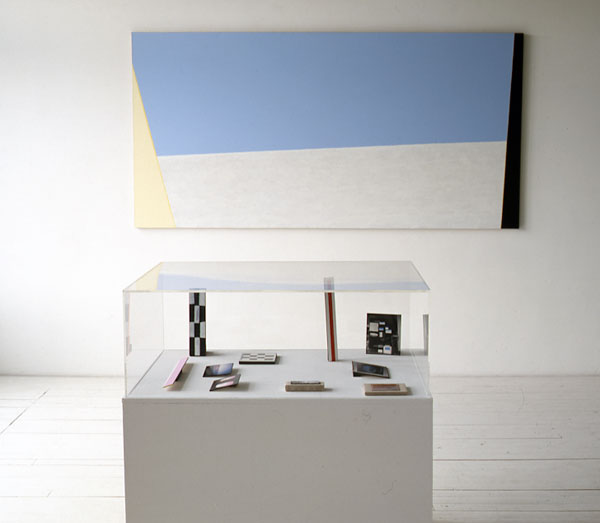JCJ Vanderheyden
.
Scepticism plays an important part in J.C.J. van der Heyden's life. It generates a degree of intelligence in his work. When he looks at his paintings or objects a few days after making them, they all evoke a number of antitheses which set him off on a variety of courses. It has nothing to do with capriciousness - despite what some people say.
His studio demonstrates this quite clearly; a place of reflections and intriguing duplications. It is a small room, in which all the objects stand and hang close together. It is easy to see how they are related. A big painting, a blue border on a white ground, next to it or diagonally opposite the same motif - but very small. Nearby, a mirror which at a certain angle changes the proportions of the two paintings: the small one looks bigger and the big one smaller. Van der Heyden, when you visit him in his studio, gives you the feeling that he spends hours gazing at that mirror (or other mirrors). That's how he discovered that images can be manipulated, and that's how he found out that he had to be sceptical about their constancy - and that their intelligence dwelt in their changebility. For someone who, like everyone of that generation, started off as an expressionist, this is a tremendous discovery: that the painting need not to be an explosion, stuck firmly to the canvas - but that it can be done coolly, changed, tirned, enlarged, diminished, made higher or narrower. It has nothing to do with style or handwriting, for the painting does not really exist; it is a manifestation of a procedure - real or mirrored.
I first visited J.C.J. van der Heyden's studio in Den Bosch in 1963. I had visited artists before - Cees Buurman and Jan Maaskant, who I knew in Leiden, but their studios were workshops. J.C.J. van der Heyden's one was a construction which mirrored the construction of his works: a cabinet of constructions. This is all hindsight; at the time I probably didn't understand.
The interesting thing is that what we saw in Van der Heyden's studio that day in Den Bosch was happening all over the world just then. The work of art as a form to be intellectually manipulated - the form regardless of 'ordinary' reality. At that moment, in 1963, Luciano Fabro was working in Milan, Penck in Dresden, Buren in Paris, Polke in Dusseldorf and Donald Judd in New York. They were not yet acquainted.
R.H. Fuchs

exhibition view at Galerie van Gelder, Amsterdam 1988
